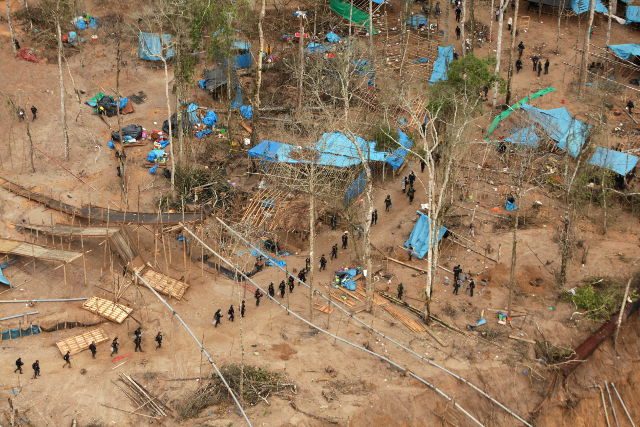SUMMARY
This is AI generated summarization, which may have errors. For context, always refer to the full article.

HUEPETUHE, Peru – A lush expanse of Amazon rainforest known as the “Mother of God” is steadily being destroyed in Peru, with the jungle giving way to mercury-filled tailing ponds used to extract the gold hidden underground.
Locals describe the area as a tropical Wild West where tens of thousands of desperate fortune-hunters have set up camp around improvised mines that operate around the clock, use heavy machinery to rake open the land and leech toxic chemicals into the ground.
The region is in the spotlight as Peru prepares to host a major United Nations climate conference from December 1 to 12.
At the talks, known as COP20, delegates from governments around the world will try to hammer out a global deal on cutting Earth-warming carbon emissions, to be ratified next year.
But the host country’s own track record has come under fire.
Mother of God (“Madre de Dios” in Spanish), which sits on Peru’s border with Brazil, holds one of the largest uninterrupted stretches of rainforest left in the Amazon.
But about 50,000 hectares (125,000 acres) of forest have already been destroyed in the southeastern region, according to Peru’s environment ministry.
It will take “at least 40 years” for the damaged areas to recover, said the head of the Peruvian Amazon Research Institute (IIAP), Ronald Corvera.
“There’s a ton of gold here. And what’s happening is that poor people are coming from all over the place to get it,” said mining engineer Raul Ramos, who has worked in the region for more than a decade.
Mining invasion
Illegal mining is big business in Peru.
Operating 24 hours a day, some mines manage to extract 400 grams (14 ounces) of gold a day.
Informal miners, who have their own export channels, earn about $25,000 per kilogram for the valuable metal, said Ramos.
The basin of the Madre de Dios and Inambari rivers, a roughly 400-kilometer (250-mile) stretch, contains gold reserves estimated to be worth $500 billion – 15 times Peru’s foreign debt, according to a study by ESAN University.
The South American country is now the world’s fifth gold producer, with annual output of 164 tons, according to the ministry of energy and mines.
About 20 percent of that total comes from illegal mining.
Some 50,000 miners have descended on Madre de Dios in recent years, setting up enormous camps that the authorities say are beset by violence.
In La Pampa, the largest camp, fights break out often and are frequently settled with guns.
“There are several deaths a week. Sometimes the bullet-riddled bodies sit there for days. People also just disappear sometimes, they kill them and bury them and nobody ever sees them again,” said one miner who did not disclose his name.
Police get paid in gold to turn a blind eye, the miner said.
“One time recently when the police came they put 106 kilos (of gold) on the table to get them to go away.”
The Peruvian government has vowed to crack down, and has launched several police and military operations to destroy illegal mining equipment and arrest those responsible.
“There will be no truce with illegal mining. The operations will continue until it’s wiped out,” said Aldo Soto, a retired general who heads the government’s effort to deal with the problem.
Toxic fish
Despite the destruction, the region still draws about 100,000 foreign tourists a year, lured to its lush Amazon reserves.
“We can’t have mining in the rainforest. It’s incompatible,” said Eddy Pena, the head of the Peruvian Society for Environmental Law in Puerto Maldonado, the capital of Madre de Dios.
Illegal mines dump an estimated 30 to 40 tons of mercury into the region’s rivers every year, contaminating them and their fish, according to the Peruvian government.
A Stanford University study found that the region’s indigenous people had up to five times the internationally accepted level of mercury in their bodies.
“It’s an extraction economy here. People survive on what they remove from nature,” said Eduardo Salhuana, the head of the Madre de Dios Miners’ Federation.
In a different era, the region’s inhabitants tapped rubber trees. Then it was logging, and now gold.
“With the arrival of COP20 they’re going to lie to the whole world because nothing has improved here. Lawlessness reigns and the state is absent,” said Salhuana. – Rappler.com
Add a comment
How does this make you feel?
There are no comments yet. Add your comment to start the conversation.